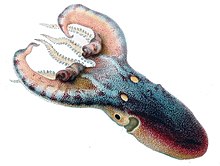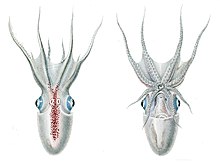印太水孔蛸
| 印太水孔蛸 | |
|---|---|

| |

| |
| 科学分类 | |
| 界: | 动物界 Animalia |
| 门: | 软体动物门 Mollusca |
| 纲: | 头足纲 Cephalopoda |
| 目: | 八腕目 Octopoda |
| 科: | 水孔蛸科 Tremoctopodidae |
| 属: | 水孔蛸属 Tremoctopus |
| 种: | 印太水孔蛸 T. violaceus
|
| 二名法 | |
| Tremoctopus violaceus Delle Chiaje, 1830
| |
 | |
| 分布范围[2] | |
| 异名[3] | |
| |
印太水孔蛸(学名:Tremoctopus violaceus)[4]为水孔蛸科水孔蛸属下的一种大型章鱼,分布于全世界温暖海洋的远洋带。本种具有十分明显的两性异形,雌性体长可达2米(6英尺7英寸),雄性则只有2.4 cm(0.94英寸),体重差距可达10,000倍以上[5]。一直到2002年,才成功于大堡礁采集到五只雄性活体。
雄性与体长低于7 cm(2.8英寸)的雌性个体时常发现会携带有僧帽水母的触须,被认为是用于自我防卫或协助捕捉猎物。成年雌性个体触腕间的薄膜也具有抵御掠食者的作用,除了能让个体体型看起来更大之外,遭遇攻击时也能够轻易脱离摆脱攻击者[6]。印太水孔蛸的完整粒线体DNA为环状去氧核糖核酸,具有16,015对碱基[7]。
-
大型雌性仰视图
-
大型雌性俯视图
-
雌性俯视图
-
包含有交接腕的成年雄性侧视图
交配行为
[编辑]雄性印太水孔蛸右侧第三腕属交接腕,触腕间则具含精子的囊袋。当雄性准备要交配时,囊袋就会破裂,将精子释放至交接腕内,接著雄性个体会将交接腕切断并交付予雌性,一般相信雄性在交配后就会死去。雌性会将交接腕存放于外套膜内,直到需要受精时才会使用,一头雌性的外套膜内可能同时保有不同雄性个体的交接腕[5]。
两性异形
[编辑]印太水孔蛸具有已知大型动物中体型差异最大的两性异形,目前对于这样的特征有提出多个理论解释:制造卵需要消耗非常多的能量,若是越大型的雌性则越有能力制造并产下更多的卵,就能有越多后代能够存活。相较之下制造精子并不需要消耗这么多的能量,因此雄性不需要有这么大的体型。此外携带僧帽水母触须的防御行为只能用于抵挡体型较小的天敌,为了有效利用这项机制,在自然选择下倾向让体型较小的雄性生存[5]。
防卫机制
[编辑]印太水孔蛸常见的天敌包括大青鲨[8]、鲔鱼[9]与旗鱼[9]。雌性个体有能力将自身卷起,并将薄膜展开[10];薄膜能让它们的体型看起来更大,甚至是将薄膜脱落来转移掠食者的注意力[11]。
最早于1963年就发现到雄性印太水孔蛸具有透过第四触腕携带僧帽水母触须的行为,目前并不知道它们自身是否有对触须刺丝胞的毒性免疫。触须被认为同时可用于自我防卫与协助捕捉猎物[12]。
参考文献
[编辑]- ^ Allcock, L. Tremoctopus violaceus. The IUCN Red List of Threatened Species. 2014, 2014: e.T174487A1415800 [20 November 2021]. doi:10.2305/IUCN.UK.2014-3.RLTS.T174487A1415800.en
 .
.
- ^ Jiménez-Badillo, María de Lourdes; Meiners-Mandujano, César; Galindo-Cortes, Gabriela; Morillo-Velarde, Piedad S.; González-Gómez, Roberto; Barriga-Sosa, Irene de los Angeles; Pliego-Cárdenas, Ricardo. The first record of Tremoctopus violaceus sensu stricto Delle Chiaje, 1830 in southwestern Gulf of Mexico gives a hint of the taxonomic status of Tremoctopus gracilis. ZooKeys. 2021, (1012): 55–69. PMC 7854555
 . PMID 33584108. doi:10.3897/zookeys.1012.55718.
. PMID 33584108. doi:10.3897/zookeys.1012.55718.
- ^ Sweeney, M.J. & R.E. Young (2004). Taxa Associated with the Family Tremoctopodidae Tryon, 1879 (页面存档备份,存于互联网档案馆). Tree of Life Web Project.
- ^ Common Blanket Octopus Tremoctopus violaceus. BioLib Biological Library. [24 May 2022]. (原始内容存档于2022-05-24).
- ^ 5.0 5.1 5.2 Norman, M. D.; Paul, D.; Finn, J.; Tregenza, T. First encounter with a live male blanket octopus: The world's most sexually size‐dimorphic large animal. New Zealand Journal of Marine and Freshwater Research. 2002, 36 (4): 733–736. ISSN 0028-8330. doi:10.1080/00288330.2002.9517126
 .
.
- ^ Shapiro, Leo. Facts about Common Blanket Octopus. Encyclopedia of Life. [21 March 2012]. (原始内容存档于2018-06-07).
- ^ Yuh-Wen Chiu; Chih-Wei Chang; Kang-Ning Shen; Yu-Min Ju; Hung-Du Lin. Complete mitochondrial genome and the phylogenetic position of the pelagic octopus Tremoctopusviolaceus (Mollusca: Tremoctopodidae). Mitochondrial DNA Part B. 2018, 3 (2): 1248–1249. PMC 7799641
 . PMID 33474480. doi:10.1080/23802359.2018.1532347
. PMID 33474480. doi:10.1080/23802359.2018.1532347  .
.
- ^ Teodoro, Vaske. Feeding habits of the blue shark (Prionace glauca) off the coast of Brazil. Biota Neotropica. 2009, 9: 1–6. ProQuest 215438352.
- ^ 9.0 9.1 Tsuchiya, K. Cephalopods eaten by pelagic fishes in the tropical East Pacific, with special reference to the feeding habitat of pelagic fish (PDF). La Mer. 1998, 36: 57–66 [2022-07-12]. (原始内容存档 (PDF)于2022-01-10).
- ^ The Blanket Octopus and it's AMAZING Blanket!!. YouTube. 2019 [2022-07-12]. (原始内容存档于2022-07-12).
- ^ Thomas, Ronald F. Systematics, Distribution, and Biology of Cephalopods of the Genus Tremoctopus (Octopoda: Tremoctopodidae). Bulletin of Marine Science. 1977, 27 (3): 353–392 [2022-07-12]. (原始内容存档于2022-07-12) (英语).
- ^ Jones, Everet C. Tremoctopus violaceus Uses Physalia Tentacles as Weapons. Science. 1963-02-22, 139 (3556): 764–766 [2022-07-12]. Bibcode:1963Sci...139..764J. ISSN 0036-8075. PMID 17829125. S2CID 40186769. doi:10.1126/science.139.3556.764. (原始内容存档于2022-07-12) (英语).
延伸阅读
[编辑]- 印太水孔蛸 Tremoctopus violaceus Chiaie, 1830. 台湾物种名录. 台湾: 中央研究院生物多样性研究中心. [2013-01-24] (中文(台湾)).
- Powell, A. W. B. New Zealand Mollusca. Auckland, New Zealand: William Collins Publishers Ltd. 1979. ISBN 0-00-216906-1.





